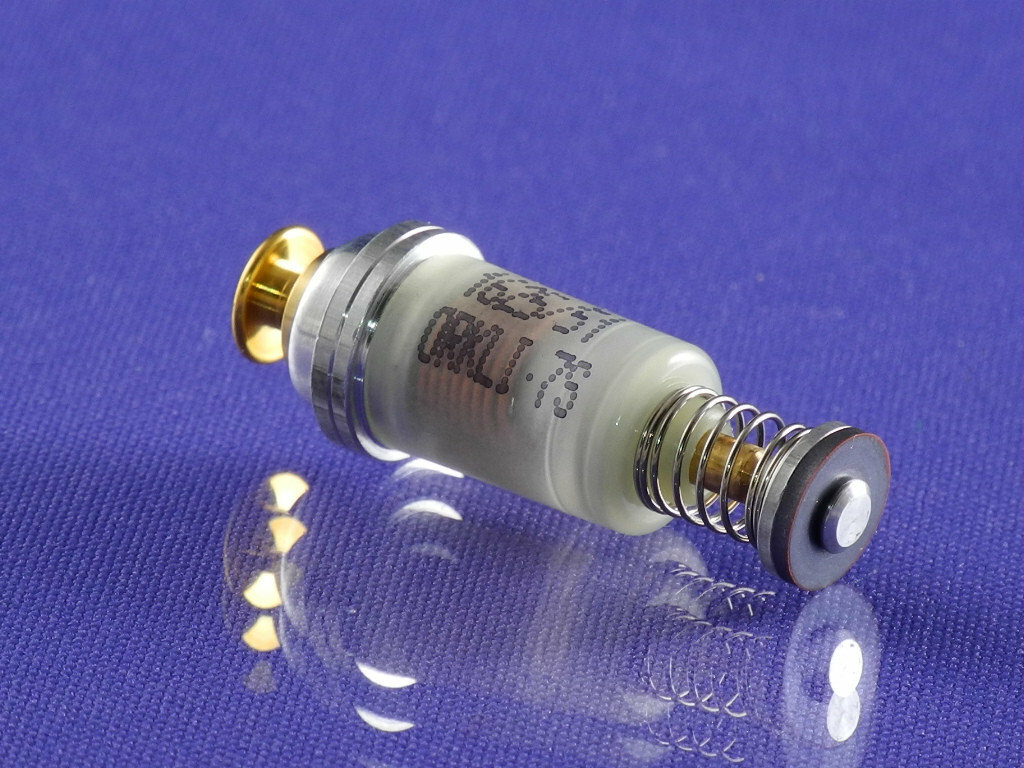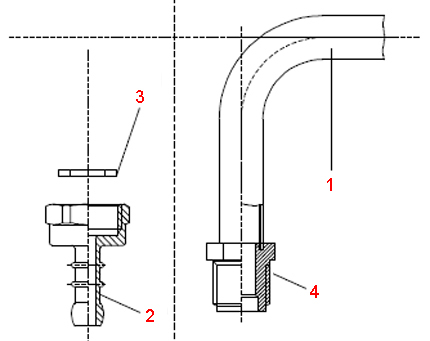Autonomous gasification is notable for the practical and economical use of blue fuel. But for filling gas tanks, the market offers winter and summer gas, which differ significantly in price.
Agree, each of us wants to save money. But is it worth doing this in the case of gas-filled fuel? Next, we will analyze in detail how good cheap LPG is, what its features are and how it will behave in winter.
The content of the article:
- Gas fuel grades for gasholder
- Difference between winter LPG and summer LPG
-
Which option should you choose?
- Features of refueling and confusion
- How not to get too cheap when buying gas?
- Conclusions and useful video on the topic
Gas fuel grades for gasholder
The most important thing is to clearly distinguish main and gas tank gas. Both options are used for both heating and cooking on the stove. However, these are fundamentally different gas compositions. In the case of the pipe, we are dealing with methane CH4, and the propane mixture C3H8 and butane C4H10. The second type of "blue" fuel will be discussed further.
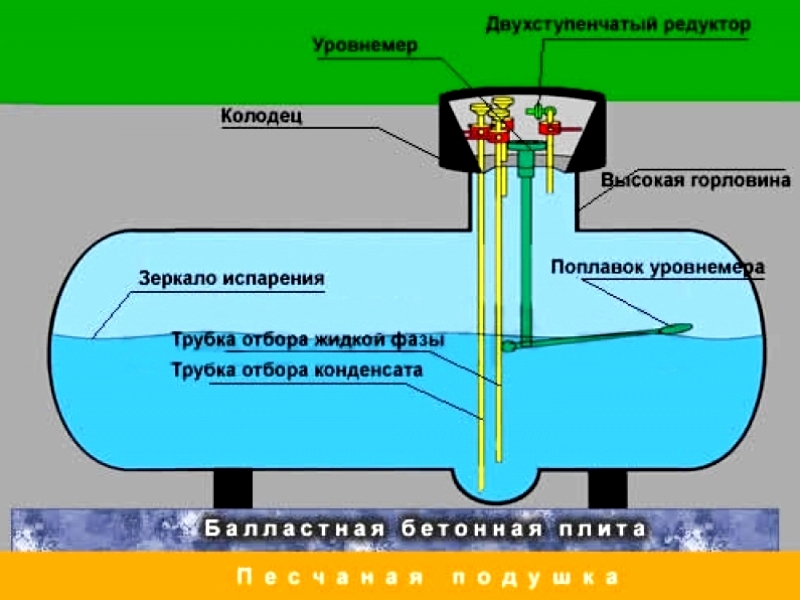
The gasholder is filled with liquefied hydrocarbon gases (LPG), which then first pass from the liquid phase to the steam phase, and then are used as fuel for boilers and cooking furnaces
A propane-butane mixture with a small amount of impurities is poured into the gasholder. Methane is not used in this case, since it is too expensive to liquefy it for use in autonomous gas supply. To obtain liquefied natural gas, the methane fraction must be cooled to -160 ° C. This is done in special plants, costs a lot of money and is used only for the transportation of LNG over long distances in large volumes.
Liquefying propane with butane is a cheaper operation. To do this, they need to be cooled to much lower temperatures than methane. Plus, you can store LPG for a long time in a simple gas cylinder or gas tank without special measures. That is why it is customary to use a propane-butane mixture in the autonomous gas supply of private households, as well as as fuel for cars.
GOST regulates the use of LPG in the form of:
- PT - technical propane;
- BT - technical butane;
- SPBT - technical mixtures of propane and butane.
The use of these brands in each specific case depends on the climatic conditions and the type of gas tank.
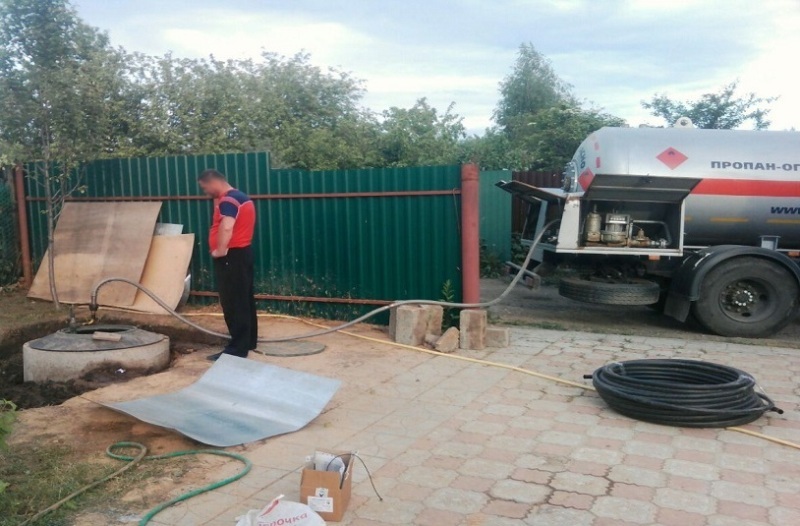
In addition to the main brands, there is also a butane-butylene fraction (BBF) on sale, which is SPBT diluted with technical water.
BBF is a cheap and low quality gas with condensate. When burned, approximately 10% less heat is generated than when using conventional TPBT. It is quite acceptable to pump such fuel into a gas tank and burn it in boilers. However, its use does not in the best way affect the service life of gas equipment, significantly reducing it.
Difference between winter LPG and summer LPG
A mixture of propane and butane in a gaseous state is well mixed with air, which guarantees its uniform combustion and complete combustion. At the same time, GOST provides for a floating ratio of the shares of C3H8 and C4H10 in LPG. From here comes the division of liquefied gas into summer and winter grades.
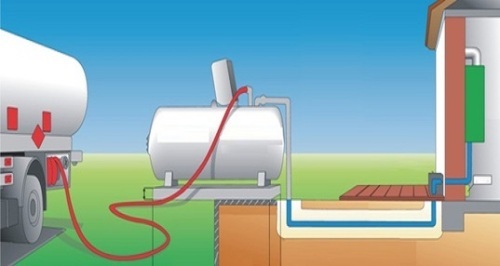
Fuel is pumped into the gasholder in the "liquid phase", and then it enters the house for combustion in a boiler or on a stove in the form of a "vapor phase"
The transition of LPG from a liquid to a vapor state occurs inside the gasholder. Moreover, if butane at normal pressure is able to pass from liquid to gas at temperatures only up to -0.5 ° C, then propane is up to -42 ° C. If, in liquefied form, this or that fuel cools below these indicators, then its transition to the vapor phase will be impossible.
When it is freezing outside at minus 10–20 ° С, butane will remain in the form of a liquid. As a result, it will become unsuitable for use in a gas heating boiler or hot water heating. The less it is in the gasholder in winter, the better.
In the "winter" gas, the proportion of propane reaches 80%, and in the "summer" it is only about 50%. Butane is much cheaper, so they try to add as much of it to LPG as possible. However, it is also difficult to do without a propane component.
Propane is responsible for the pressure in the system and the stability of the liquid / vapor phase transition. If for the winter the "summer" version of LPG is poured into the gas tank, then at some point the evaporation of the liquefied mixture will stop. As a result, the boiler will be left without fuel, and the house will be without heat.
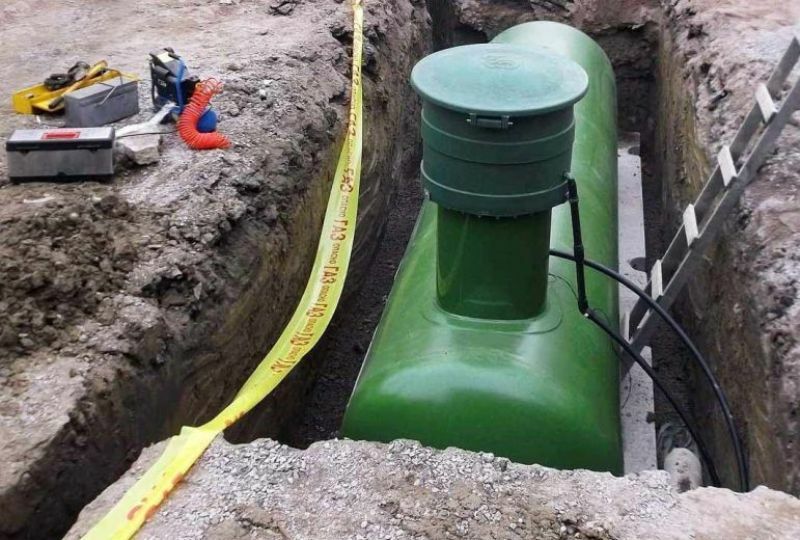
The problem of LPG freezing is partially solved by burying the gas tank below the level of soil freezing. So the heat of the earth heats the gas mixture inside the tank to temperatures around zero, ensuring its stable evaporation.
The basic difference between the "summer" and "winter" brands of gas-holder gas is the ratio of propane and butane in LPG. The more the first, the better at any time of the year. However, with an increase in the propane share, the price of fuel also increases.
If the gasholder is not buried in the ground in accordance with the requirements of SNiPs, and in winter the air temperature drops below zero, then the "summer" mixture of LPG in it will definitely stop passing into the vapor phase. And then, at the most inopportune moment, propane will completely evaporate and be consumed, and butane will never become a gas.
Which option should you choose?
The more butane in LPG, the cheaper the liquefied gas for the gas tank. But the efficiency and stability of the gas-holder equipment operation directly depends on the more expensive propane contained in the propane-butane mixture. Cheapness is not always good. Wanting to save on fuel, you can find yourself in cold weather without heating at all.
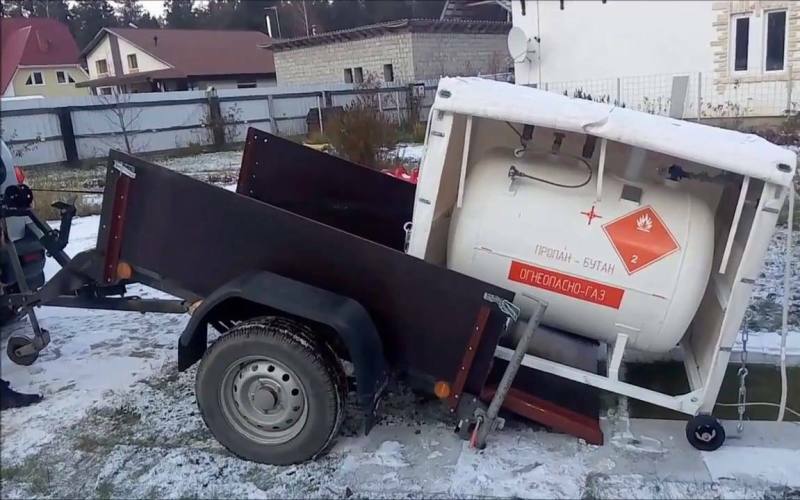
If a mobile gas tank is used without burying it in the ground, then by winter the summer LPG in it must be changed to winter, otherwise you can be left without gas for the boiler and hob
In the case of a gas-holder tank buried below the freezing level, the situation is not so unambiguous. In a warm region, the heat of the earth is usually more than enough to ensure high-quality evaporation of butane, even with short-term frosts down to -15 ° С. As a result, there is no point in spending money on an expensive winter version of LPG.
In addition, 50% propane is a good reserve in case of short-term frosts. In frosts, it will be spent, and during warming, butane will again go into the boiler. This will not create any problems for gas equipment.
However, if a house with a gas holder is located in a cold or very cold climatic area, then you cannot do without the use of fuel with a high propane content. In such a region, it is better to fill the gas tank with gas specially designed for winter in advance in the fall. You should not save here, otherwise you will have to freeze.
We also recommend that you familiarize yourself with the rules for installing a gas tank on the site. More details - go link.
Features of refueling and confusion
According to the norms, the gasholder is filled with liquefied gas not completely, but by 85%. The remaining 15% is needed for the liquid / vapor phase transition and the creation of pressure inside the vessel. If you fill the tank during the year with only summer mixture, then in winter butane in the form of a liquid will accumulate in it to the eyeballs. Then it will be simply impossible to add new fuel with propane, and the existing one cannot be used for its intended purpose.
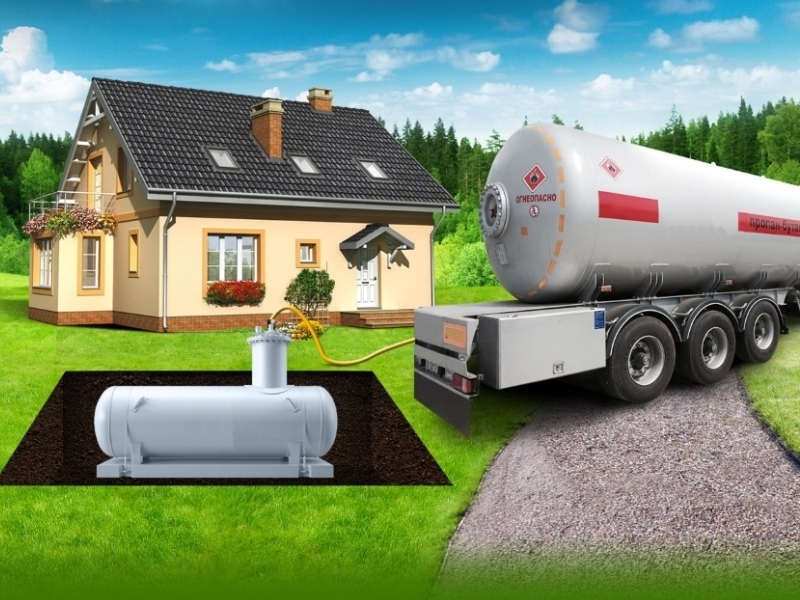
From the point of view of refueling, there is no difference between summer and winter gas - in both cases, the same gas carrier vehicle and the same gas tank are used.
Entanglement of the gas tank is a serious problem. To pump out the formed "condensate", you will have to call the gas workers. At the same time, they will take a lot of money for pumping, and then they will dilute the pumped out butane with propane and pour it again into someone gas tank. For the supplier there is a double weld, and for the owner of the autonomous gas supply system, one costs. It is better not to allow such a situation from the very beginning.
To avoid confusion, use one of three methods:
- By winter through autumn, "winter" LPG is poured into the gas tank.
- A special evaporator is installed for the forced conversion of liquefied butane into gas.
- The gas tank is wrapped from the outside with a heating cable.
The first method is most often used. But the second two should not be ruled out either. The operation of the evaporator and heating cable is energy consumption. But if such equipment is installed and used, then you can safely order cheap "summer" gas for the winter.
How not to get too cheap when buying gas?
The price difference between summer and winter gas is about 30-40%. It is sold cheapest in spring and most expensive in autumn. And of course I want to save money here, especially if the gas tank is spacious. However, if LPG is offered at a cost per liter much lower than the market in a particular region, then you should seriously think about it.
It is impossible to unambiguously indicate which gas is best to be poured into the gas tank for the winter, the final decision depends on:
- type of installed capacity;
- climate of the region;
- presence / absence of additional equipment.
In some situations, it is more profitable to install a forced evaporator for butane and purchase cheap summer gas, while in others it is more profitable to make a choice exclusively in favor of winter LPG. For each specific case, the calculation of costs must be done individually. Moreover, the price of liquefied propane is different in each region.
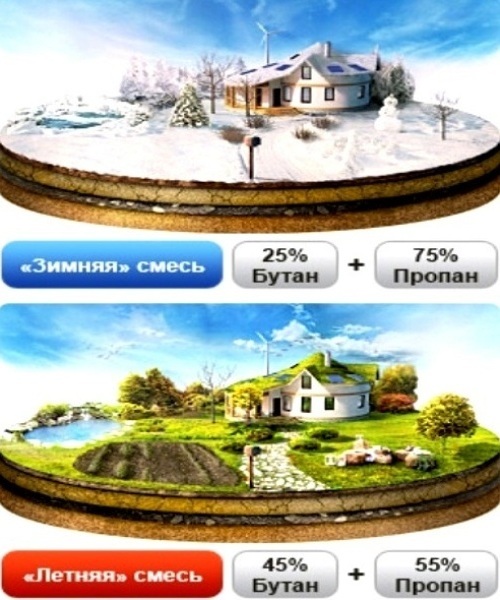
According to the standards, LPG should be poured into gas tanks in the form of SPBT in the winter or summer version, but a negligent and especially cunning supplier can slip a much cheaper analogue of BBF
The cost of filling the gas tank depends on:
- fullness of the container;
- remoteness of the settlement;
- seasonality and type of gas (summer or winter);
- the volume of actual injection and the size of the barrel of the ordered LNG carrier.
If you come across a supplier on the market with a very low price, then you should once again think about how high-quality gas he has. On the one hand, it is capable of slipping summer LPG instead of winter LPG, and on the other, it can completely fill the gas holder with a poor-quality mixture with condensate and impurities.
You should buy fuel for the gas tank only from time-tested sellers. In case of problems, replacing a container for liquefied gas will cost a round sum. Excessive savings on fuel are potential and often inevitable costs of repairing gas equipment.
Conclusions and useful video on the topic
Recommendations for refueling the minigas holder:
The process of pumping out gas from a gas-holder tank for its repair:
How they cheat when refueling a gas tank:
In summer, winter gas will burn without any problems. But the use of summer LPG in winter is not always possible. In order not to encounter cold with low pressure in the gasholder due to slow vaporization, it is best to fill it with liquefied fuel with a high propane content in the fall. But if the region is warm or special equipment is installed, then it is quite acceptable to fill the container with a cheap summer propane-butane mixture all year round.
Leave your comments, ask questions, share your experience and participate in the discussion of this material. The communication block is located under the article.

